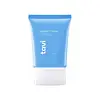What's inside
What's inside
 Key Ingredients
Key Ingredients

 Benefits
Benefits

 Concerns
Concerns

 Ingredients Side-by-side
Ingredients Side-by-side

Ethylhexyl Palmitate
EmollientTriethylhexanoin
MaskingGlycerin
HumectantCoco-Caprylate/Caprate
EmollientWater
Skin ConditioningPolyglyceryl-10 Myristate
Skin ConditioningPropylene Glycol Laurate
Skin ConditioningKaolin
AbrasiveFicus Carica Fruit Extract
HumectantCentella Asiatica Extract
CleansingCamellia Sinensis Leaf Extract
AntimicrobialHelianthus Annuus Seed Oil
EmollientSimmondsia Chinensis Seed Oil
EmollientHydrogenated Lecithin
EmulsifyingCaprylic/Capric Triglyceride
MaskingSucrose Stearate
Emollient1,2-Hexanediol
Skin ConditioningSucrose Laurate
EmollientSucrose Myristate
EmollientPanthenol
Skin ConditioningZea Mays Germ Oil
EmollientPentaerythrityl Tetra-Di-T-Butyl Hydroxyhydrocinnamate
AntioxidantButylene Glycol
HumectantSucrose
HumectantHyaluronic Acid
HumectantSaccharomyces Ferment Filtrate
HumectantCeramide NP
Skin ConditioningCholesterol
EmollientCitric Acid
BufferingEthylhexyl Palmitate, Triethylhexanoin, Glycerin, Coco-Caprylate/Caprate, Water, Polyglyceryl-10 Myristate, Propylene Glycol Laurate, Kaolin, Ficus Carica Fruit Extract, Centella Asiatica Extract, Camellia Sinensis Leaf Extract, Helianthus Annuus Seed Oil, Simmondsia Chinensis Seed Oil, Hydrogenated Lecithin, Caprylic/Capric Triglyceride, Sucrose Stearate, 1,2-Hexanediol, Sucrose Laurate, Sucrose Myristate, Panthenol, Zea Mays Germ Oil, Pentaerythrityl Tetra-Di-T-Butyl Hydroxyhydrocinnamate, Butylene Glycol, Sucrose, Hyaluronic Acid, Saccharomyces Ferment Filtrate, Ceramide NP, Cholesterol, Citric Acid
Isododecane
EmollientParaffinum Liquidum
EmollientGlycerin
HumectantEthylhexyl Palmitate
EmollientWater
Skin ConditioningGlyceryl Stearate
EmollientSucrose Palmitate
EmollientSucrose Stearate
EmollientIsomalt
HumectantButylene Glycol
HumectantBetaine
HumectantSodium PCA
HumectantSodium Lactate
BufferingPCA
HumectantSerine
MaskingAlanine
MaskingGlycine
BufferingLecithin
EmollientLycium Barbarum Callus Culture Extract
Skin ConditioningGlutamic Acid
HumectantLysine Hcl
Skin ConditioningThreonine
Arginine
MaskingCallicarpa Japonica Fruit Extract
Skin ConditioningProline
Skin ConditioningPhenoxyethanol
PreservativeBHT
AntioxidantBisabolol
MaskingTocopheryl Acetate
AntioxidantEthylhexylglycerin
Skin ConditioningIsododecane, Paraffinum Liquidum, Glycerin, Ethylhexyl Palmitate, Water, Glyceryl Stearate, Sucrose Palmitate, Sucrose Stearate, Isomalt, Butylene Glycol, Betaine, Sodium PCA, Sodium Lactate, PCA, Serine, Alanine, Glycine, Lecithin, Lycium Barbarum Callus Culture Extract, Glutamic Acid, Lysine Hcl, Threonine, Arginine, Callicarpa Japonica Fruit Extract, Proline, Phenoxyethanol, BHT, Bisabolol, Tocopheryl Acetate, Ethylhexylglycerin
Ingredients Explained
These ingredients are found in both products.
Ingredients higher up in an ingredient list are typically present in a larger amount.
Butylene Glycol (or BG) is used within cosmetic products for a few different reasons:
Overall, Butylene Glycol is a safe and well-rounded ingredient that works well with other ingredients.
Though this ingredient works well with most skin types, some people with sensitive skin may experience a reaction such as allergic rashes, closed comedones, or itchiness.
Learn more about Butylene GlycolEthylhexyl Palmitate, also known as octyl palmitate, is created from 2-ethylhexyl alcohol and palmitic acid. It is a fatty acid ester.
The fatty acid content of Ethylhexyl Palmitate makes it an emollient. Emollients help soften and hydrate your skin by trapping moisture within.
Ethylhexyl Palmitate is also used to help improve the texture of cosmetics. It helps other ingredient dissolve in products and help disperse ingredients more evenly.
You'll likely find this ingredient in sunscreen, as it is often used to mix UV-blocking ingredients such as avobenzone and ethylhexyl triazone.
It can also help stabilize the fragrances in a product as a fragrance fixative.
Ethylhexyl Palmitate can be used to substitute mineral oil.
Due to its high fatty acid content, it may not be fungal-acne safe.
Learn more about Ethylhexyl PalmitateGlycerin is already naturally found in your skin. It helps moisturize and protect your skin.
A study from 2016 found glycerin to be more effective as a humectant than AHAs and hyaluronic acid.
As a humectant, it helps the skin stay hydrated by pulling moisture to your skin. The low molecular weight of glycerin allows it to pull moisture into the deeper layers of your skin.
Hydrated skin improves your skin barrier; Your skin barrier helps protect against irritants and bacteria.
Glycerin has also been found to have antimicrobial and antiviral properties. Due to these properties, glycerin is often used in wound and burn treatments.
In cosmetics, glycerin is usually derived from plants such as soybean or palm. However, it can also be sourced from animals, such as tallow or animal fat.
This ingredient is organic, colorless, odorless, and non-toxic.
Glycerin is the name for this ingredient in American English. British English uses Glycerol/Glycerine.
Learn more about GlycerinSucrose Stearate is derived from stearic acid and sucrose (sugar). It is an emollient and emulsifier.
As an emulsifier, it prevents oils and water from separating in a product. This property also makes it a surfactant and therefore a cleansing agent.
Water. It's the most common cosmetic ingredient of all. You'll usually see it at the top of ingredient lists, meaning that it makes up the largest part of the product.
So why is it so popular? Water most often acts as a solvent - this means that it helps dissolve other ingredients into the formulation.
You'll also recognize water as that liquid we all need to stay alive. If you see this, drink a glass of water. Stay hydrated!
Learn more about Water